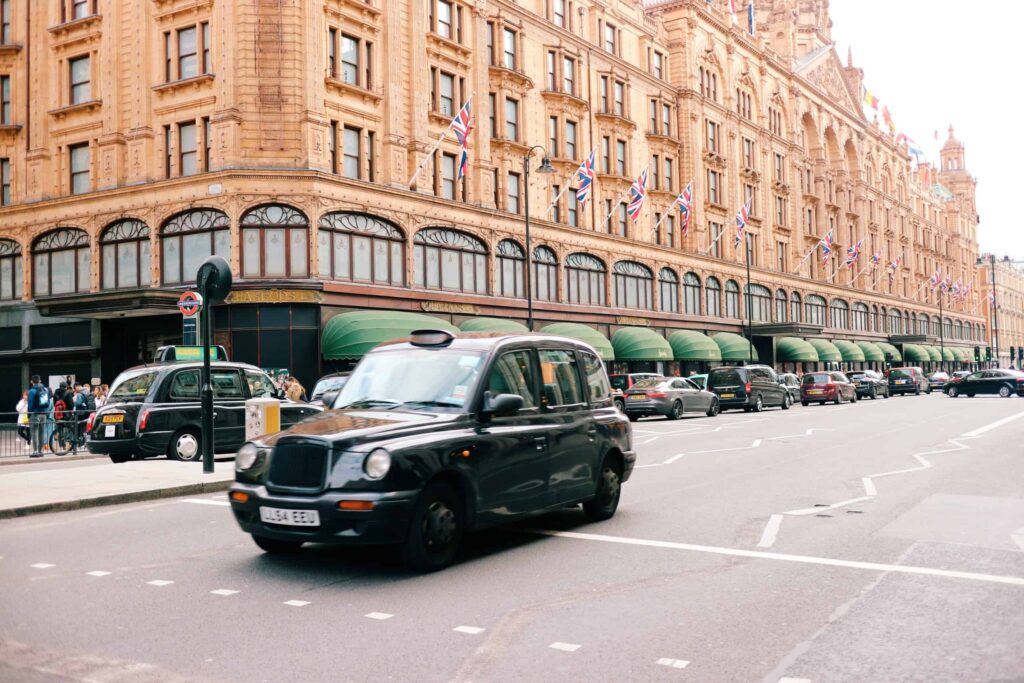

Looking to see a more local side of London without sacrificing style and charm? Head to Northwest London. It’s polished, posh, and packed with hidden gems that blend royal history, iconic landmarks, and peaceful green spaces.
Kick things off with breakfast in Marylebone (pronounced Mar-le-bone). It’s well-connected via the Circle, District, Hammersmith & City, and Bakerloo lines. Arrive at Edgware Road or Baker Street and you’re in the heart of the action.
This area buzzes with locals hustling through their daily grind. It’s an energetic, electric slice of London life that feels like you’re living here—not just visiting.
Pro tip: Blend in. Tourists can stand out, and not always in a good way. Be respectful, stay aware, and enjoy the vibe.
Baker Street is touristy but fun. It’s home to Madame Tussauds, The Sherlock Holmes Museum, and a fab little Beatles souvenir shop. If you’re doing Madame Tussauds, book ahead—it gets busy.
Not into wax figures? Keep walking. There’s more charm just a few blocks away.
Behind Madame Tussauds lies Regent’s Park—peaceful, elegant, and totally Insta-worthy. It’s one of London’s most manicured parks, with perfect pathways, colorful gardens, and endless benches to people-watch from.
At the north end, you’ll find the London Zoo. It’s a fun visit if you’ve got the time. If not, head a little further north to Primrose Hill for jaw-dropping city views.
From Regent’s Park, follow the road west into St. John’s Wood, home to Abbey Road Studios and the famous crosswalk from the Beatles album cover.
People stop traffic to recreate the album cover, but be careful—locals aren’t thrilled about the daily photo shoots. Snap your pic quickly, then move along!
Important: Google Maps lies. The real crosswalk is right outside the studio at the junction of Abbey Road, Grove End Road, and Garden Road.
So, while I love Google, they have the location of the crosswalk noted incorrectly. Just head to the actual Abbey Road studio and you can see the crosswalk from there.
As Beatle legend has it, the boys were working on the album and didn’t have any ideas for the cover art, or the album name as it turns out! So they took a break, went outside, and walked across the road. The rest is history…
After your Abbey Road adventure, circle back toward Marylebone and stop at The Globe on Marylebone Road. This place nails classic British pub fare. Order the fish and chips with mushy peas and a pint. You won’t regret it.
If you’re too tired to walk back, consider an Uber. The nearest tube at Maida Vale is a hike and offers little to see on the way.
Hop on the Central, Circle, or District line and head to Notting Hill Gate. Yes, that Notting Hill. It’s chic, colorful, and full of surprises.
Notting Hill made its mark on the collective consciousness of pop culture in the Hugh Grant-Julia Roberts film of the same name. Here you will find the popular Portobello Road street market shown in the film.
Don’t miss the giant Waterstones bookstore. It’s a gem. Hugh Grant may not be behind the counter, but a girl can dream, right?
From Notting Hill Gate, take a short walk east into Kensington Gardens. Inside the park, you’ll find Kensington Palace—once home to Queen Victoria, Princess Diana, and now the Prince and Princess of Wales.
Tour the palace to see Victoria’s childhood room, royal gowns, tiaras, and the unforgettable black velvet dress Diana wore dancing with John Travolta. Check for timed entry tickets before you go.
The palace is still home to many members of the Royal Family today, so the public has access to only a portion of the palace. I took the tour here on one rainy afternoon and it was fascinating! No advance ticket was required at that time but check before going.
Also, don’t skip the Diana Memorial Fountain. It’s subtle and serene, just like her.

On the south side of Kensington Gardens is the stunning Royal Albert Hall, still hosting concerts today. Across from it stands the Albert Memorial, a grand tribute to Prince Albert’s legacy in the arts.
Both sites are worth a visit—even just to gawk at the Victorian-era architecture.

Along with the music hall, there is also a spectacular monument dedicated to Prince Albert, consort to Queen Victoria, just across the street.
Prince Albert was largely responsible for much of the monarchy’s support of the industrial revolution during the Victorian era. His passion for the advancement in arts and culture encouraged lawmakers to provide the funding needed for many creative endeavors in the early half of the 19th century. 💜
He was a lover of poetry, music, and the arts. The monument outside the music hall clearly reflects that passion. The public’s appreciation of his respect for the artists is evident in the sheer scale of this monument.
When he died so very young, at the age of just 42, the funding and amplification of the arts died with him. Victoria famously went into seclusion for decades.
Artists were left on their own to find a way of elevating their work without the pedestal of the monarchy for public support.

Now that you’re in upscale Kensington, you’re near Harrods. It’s luxury central—Hermès bags, Rolex watches, Dom Pérignon on the shelves. Even if you’re just window shopping, it’s an experience.
If your wallet’s not quite Harrods-ready (same), take a cab to Westfield London in Shepherd’s Bush. It’s massive, modern, and full of shops at all price points. Finish your day with dinner at one of the open-air restaurants and soak in the lively night scene.
If you enjoyed this post, read on to my Day 3 London itinerary and explore The Tower of London!
